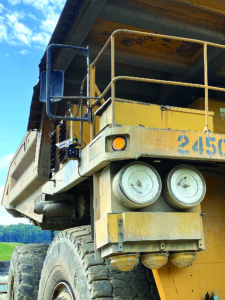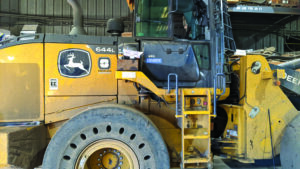
Hexagon Mining’s HxGN MineProtect collision avoidance system mitigates risks at the mine site. (Photo: Hexagon Mining)
Technology may help some mine operators comply with parts of an expected new rule from MSHA
By Steve Fiscor, Editor-in-Chief
The Mine Safety and Health Administration (MSHA) proposed a new rule, Safety Program for Surface Mobile Equipment (86 Fed. Reg. 50496) during September 2021. The agency extended the comment period for the rulemaking and completed that part of the rulemaking process during February 2023. While MSHA has provided no further updates and was unwilling to comment publicly, many believe for better or worse the rule will take effect later this year, possibly this summer. Mine operators would then have to develop and implement the plan within six months of the effective date.
For those employing six or more miners, the new rule would make mine operators develop and implement a written safety program for mobile and powered haulage equipment, excluding conveyor systems, at surface mines and the surface areas of underground mines. The written program would include actions mine operators would take to identify hazards and risks to reduce incidents related to surface mobile equipment.
Some aspects of the proposed rule are well-meaning, but subjective in nature. That has caused concern for mine operators, many of whom are already paying excessive legal fees to contest MSHA citations for inconsistent interpretations of the laws already in place. For example, MSHA’s proposal would offer mine operators flexibility to devise a safety program that is appropriate for their specific mining conditions and operations. Without district-level approval of the plan, however, each inspector that visits the mine could agree or disagree with what the mine believes is acceptable.
Under the proposed rule, the mine would designate a responsible person with authority and responsibility to evaluate and update the written safety program for surface mobile equipment. It requires the mine operator to identify, collect and review information about hazards. The actions, MSHA explained, could include review of accident data and close calls. Mine operators by law already nominate a responsible person for its safety program at each operation and they see this as duplicative overreach.
The program would also include actions the mine operator would take to evaluate currently available and “feasible technologies” that can enhance safety and evaluate whether to adopt them. The program would also include a process by which operators would periodically evaluate new and existing technologies that “could” enhance safety. Examples of these systems include seat belt systems, collision avoidance systems, and GPS systems to provide operators with situational awareness as well as cameras and curvilinear mirrors.
It’s important to remember that this law applies to coal and metal/nonmetal mines. Feasible technology would have different cost thresholds for a gold miner in Nevada, a copper miner in Arizona and a coal operator in Wyoming. Technology has advanced considerably with collision avoidance and many of those tools are currently deployed on the newest models of haul trucks. Installing it on every piece of equipment that enters the mine may not be feasible, but suppliers are developing affordable, smart camera systems that could assist with compliance and possibly improve safety.
Intersection Monitoring and Pedestrian Detection
Matrix has been developing its OmniPro camera safety system that uses visual artificial intelligence (VAI) to detect people, vehicles and objects, within the projected travel path of mobile equipment and alerts the operator to their presence. They showcased the technology recently at the annual Society for Mining, Metallurgy and Exploration meeting in Denver during February.
The system has two different applications. One is machine mounted, and it can be placed on anything from a forklift to a haul truck. The other application is a permanent mount, which could be used near a dump point or at an intersection. The system does not use tags and the intelligence resides within the camera, which avoids latency issues.
“With these systems, mine operators should consider the specific use cases, especially for equipment,” said Brian Jones, vice president sales, marketing and business development for Matrix. “Is the concern at the initiation of movement? Or does the operator want to slow vehicles meeting head-to-head at full speed? Once the needs are clarified, we can determine if we can meet those needs.”
When monitoring intersections with static locations, the objective is usually to identify a vehicle or a person moving toward the intersection and then, if necessary, to take action to stop them by lowering barriers or using warning lights to notify the machine operators or pedestrians that a collision might be imminent, Jones explained.

Matrix has been testing its OmniPro VAI system on haul trucks. The camera is visible just about the wheel well. (Photo: Matrix)
Matrix has tested the OmniPro system extensively in mining, manufacturing, and other industrial settings. “The system provides the operator another set or ‘eyes’ to help see blind spots, possibly around a corner,” Jones said. “In gating applications, it’s always good to know if another vehicle is heading toward your location before you start down the ramp or decline with a load.”
More recently, Matrix has had success rolling OmniPro out above ground on different machines, Jones said. “We’re continually testing on large haul trucks to understand additional production applications,” Jones said. “The design of the system depends on what the mine wants. They will know what’s best for their operations and must decide who should be alerted and how. Audible alerting or warning lights or both? They also need to know how or if they want the system to integrate with the equipment. The decision to stop a loaded haul truck on grade is difficult. It could lead to other problems, but it also might be necessary.”
Jones admits there was a learning curve, especially with training out false alerts. “Anyone can find VAI models online,” Jones said. “They’re readily available. As the name implies, the technology is visual, and it detects what we teach it to detect. We can teach it to look for people and different types of equipment. We can teach it to look for stop signs or yield signs. The key is continuous improvement of the model to reduce false alerts.”
With OmniPro, the brains are in the camera. This improves signal processing. “With facial recognition applications on security systems, for example, the task is to identify known personnel, but this typically involves cloud processing, which induces latency. If a human or a pickup truck is in the path of a haul truck, that operator needs to be notified instantly; every second counts. These cameras are processing at frame rates that allows the system to perform its collision avoidance functions. All that processing is inside the camera on the vehicle. Nothing must go to the cloud.”
Matrix has been developing its VAI model for three years now. “It’s a highly customized model that reacts quickly and accurately for a pedestrian or vehicle alerting application. That’s incredibly important to avoid the false alerts that drive equipment operators crazy and could ultimately lead to complacency. We’ve gone through those pain points and come out on the other side.”
One of the important features of OmniPro is its scalability. “The system works well for mobile equipment and intersection monitoring, but it also collects data,” said Brad Coats, technical sales representative for Matrix. “All of that data is available through a dashboard, allowing users to see trends. It gives mine operators the ability to see what happened during close calls. They can then determine whether it’s a procedural error with training, or a traffic problem or something else.

Matrix has had success rolling OmniPro out above ground on different machines. (Photo: Matrix)
“Accidents don’t just happen,” Coats said. “There are a series of events that led up to the incident. OmniPro gives the mine operator the data needed to analyze the situation. Looking at trends could help them avoid future accidents.”
Matrix has designed the system to withstand the rigors of the mining environment. “We currently have cameras deployed at one of the worst environments for electronics, an underground salt mine,” Coats said. “It’s humid, it’s hot, and there is inherently corrosive salt in the air. It has been operating there for close to two years now.”
“We build equipment for mine sites,” Jones said. “The cameras are durable. That being said, installation is key to success. We try to avoid mounting them where they constantly have mud or slush thrown on them.”
As far as mine site acceptance, Coats said that the operator’s first response is the feeling that Big Brother is watching. “Once they understand no one is looking over their shoulder, and it’s actually there to try to help, acceptance levels improve,” Coats said. “They usually find that the in-cab display can also be used as a backup camera.”
Common sense is always first and foremost with safety considerations, Coats explained. “At the same time, it’s nice to have a backup,” Coats said. “Mines nowadays are seeing so many third-parties coming on-site, and the machine operators don’t know how that person will operate their vehicle or how they react to certain traffic situations, so they enjoy this. Plus, with no wearable devices, the mine doesn’t have that reoccurring cost for replacing tags.”
Currently, each OmniPro module can manage up to three cameras at a time. Usually, the equipment has forward- and rear-facing cameras, and the system automatically shifts the zone to align with the machine’s direction of travel. Each camera has a 120° field of view. A third camera could provide a full 360° view, but most applications call for 2-camera systems.
Matrix originally developed this technology for mining to address continual concerns around large-to-small vehicle interactions, but they have been approached by many companies in other industries as well, from waste management to lumber mills. “Each of them have a unique application in mind, and we have been able to customize a solution for them,” Jones said.
Hexagon Upgrades Its CAS
Last year, Tucson-based Hexagon Mining launched Version 10 of its HxGN MineProtect Collision Avoidance System, or CAS 10. The system featured two hardware upgrades, an advanced smart antenna and a new 5-in. LCD monitor. The antenna supports GPS, RF, WIFI, LTE, and Ultra-Wide Band Time-of-Flight technology. The small display is improved over predecessor screens in ease of installation and use to help the operator make better decisions.
CAS 10 encapsulates the Hexagon’s Power of One theme, explained Rob Daw, chief innovation officer for Hexagon Mining. It has “one antenna, one computer, and one screen,” he said.
“They can also run our fatigue or operator alert system, our fleet management system, and our collision avoidance system all with those three key pieces of technology,” Daw said. “We can run other sensors where needed, and having that core capability that can run multiple solutions makes it easier for operators to use our systems, which means they are safer and can be more productive.”
The standard system is easy to install, quick to configure and cost effective, according to Hexagon Mining. It consists of a display, the main unit, a combined antenna that contains the GNSS, real-time radio antennas, and Wi-Fi for real-time tracking and reporting.
HxGN MineProtect integrates sensors and software to mitigate the risks posed by busy vehicle and pedestrian traffic, blind spots, distraction, fatigue and slope instability. The CAS serves as the core for this integration and provides 360° operator awareness for surrounding vehicles and equipment, as well as a technology-leading collision avoidance function based on path prediction.
Via a non-intrusive cabin display unit, CAS protects all mining vehicles, assets, and vehicle operators within 500 m. Its analytics capabilities ensure full access and interpretation of data for continuous safety improvements.
Hexagon Mining said the system is built on reliable hardware proven in all mining environments. An optional add-on is tracking radar, which characterizes a potential threat’s position and motion, providing the information needed by drivers and supervisors.

